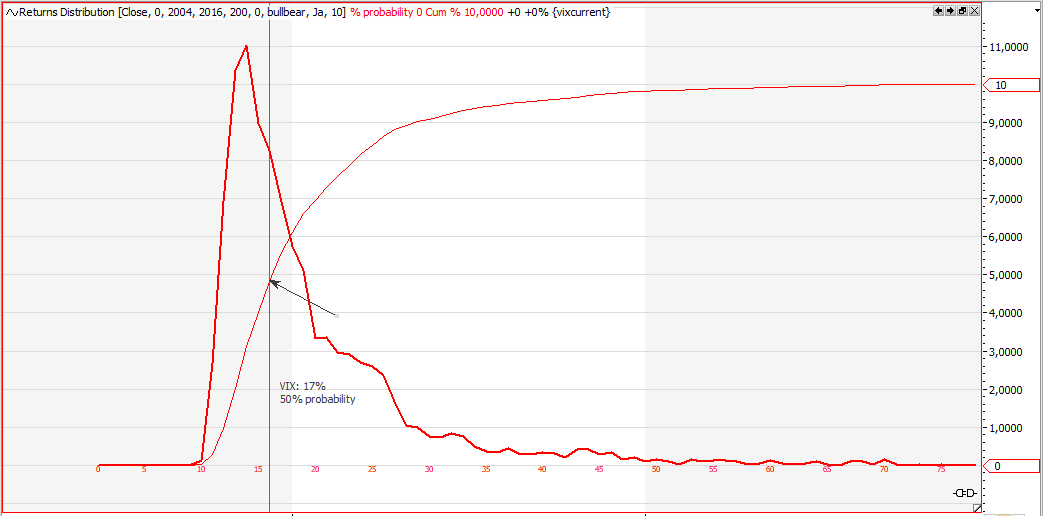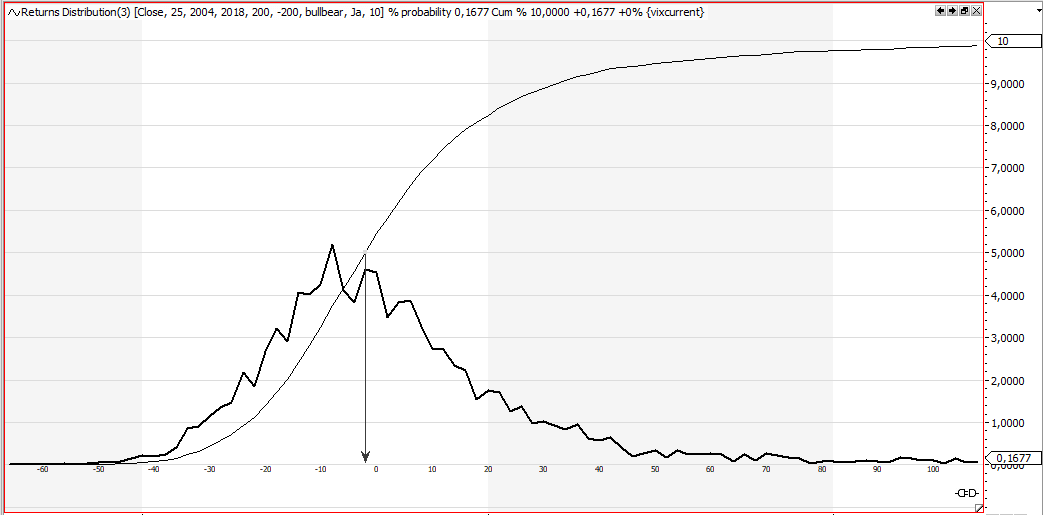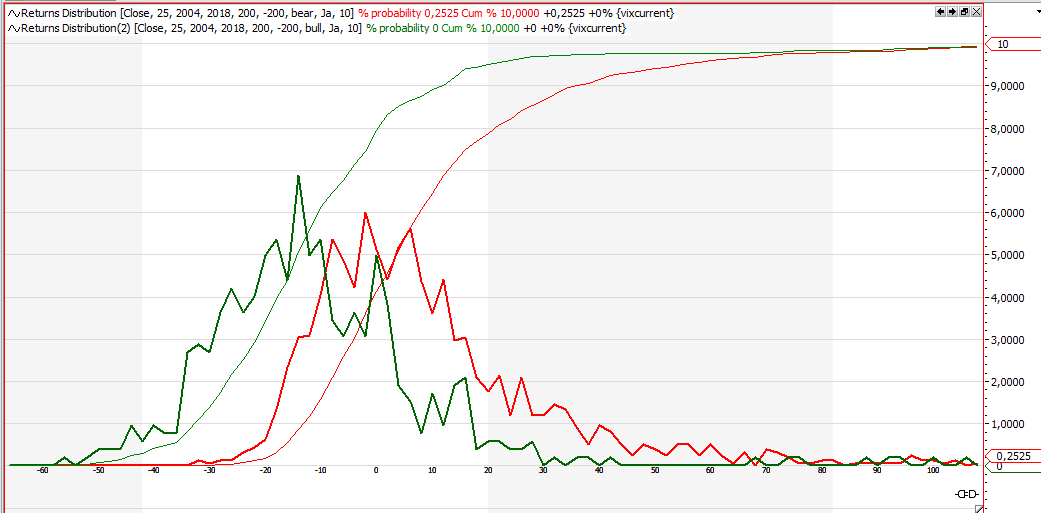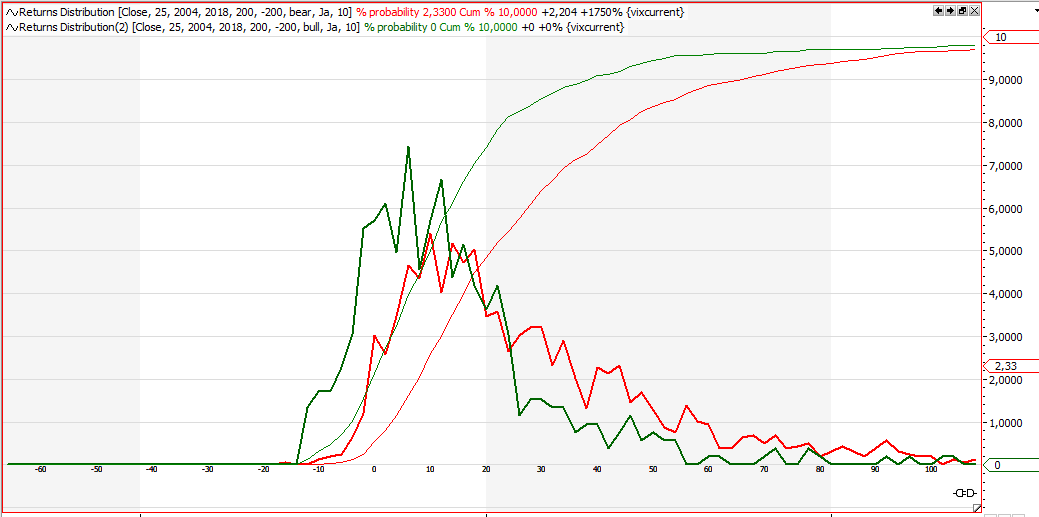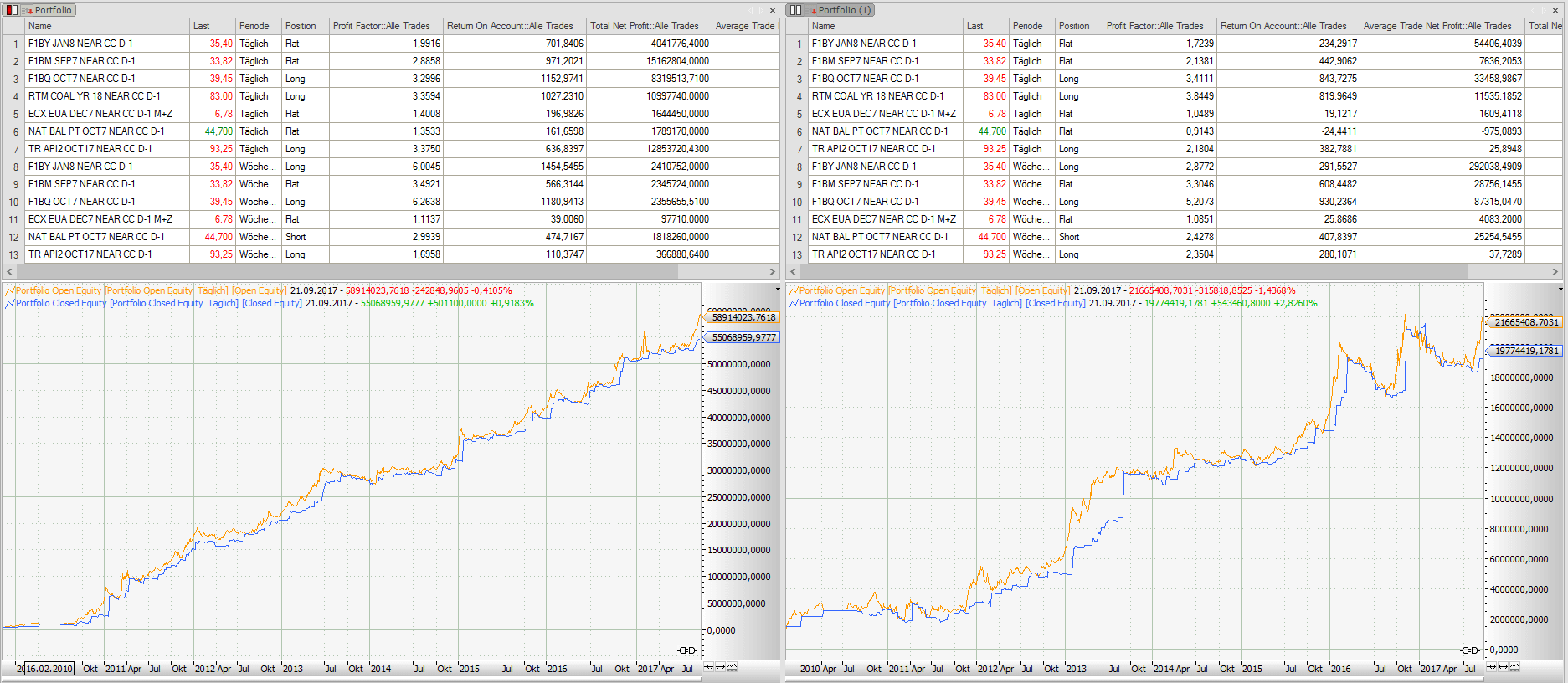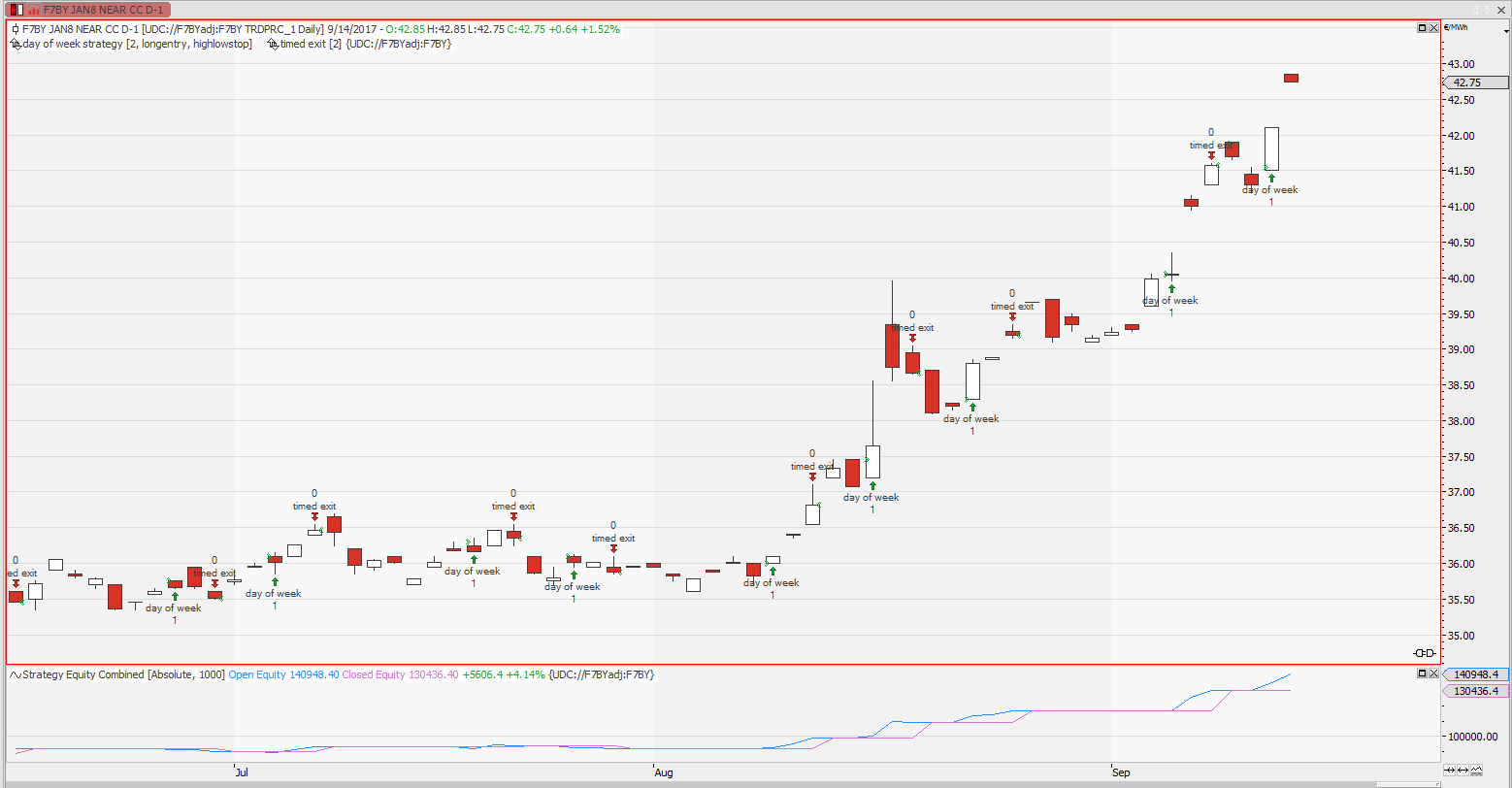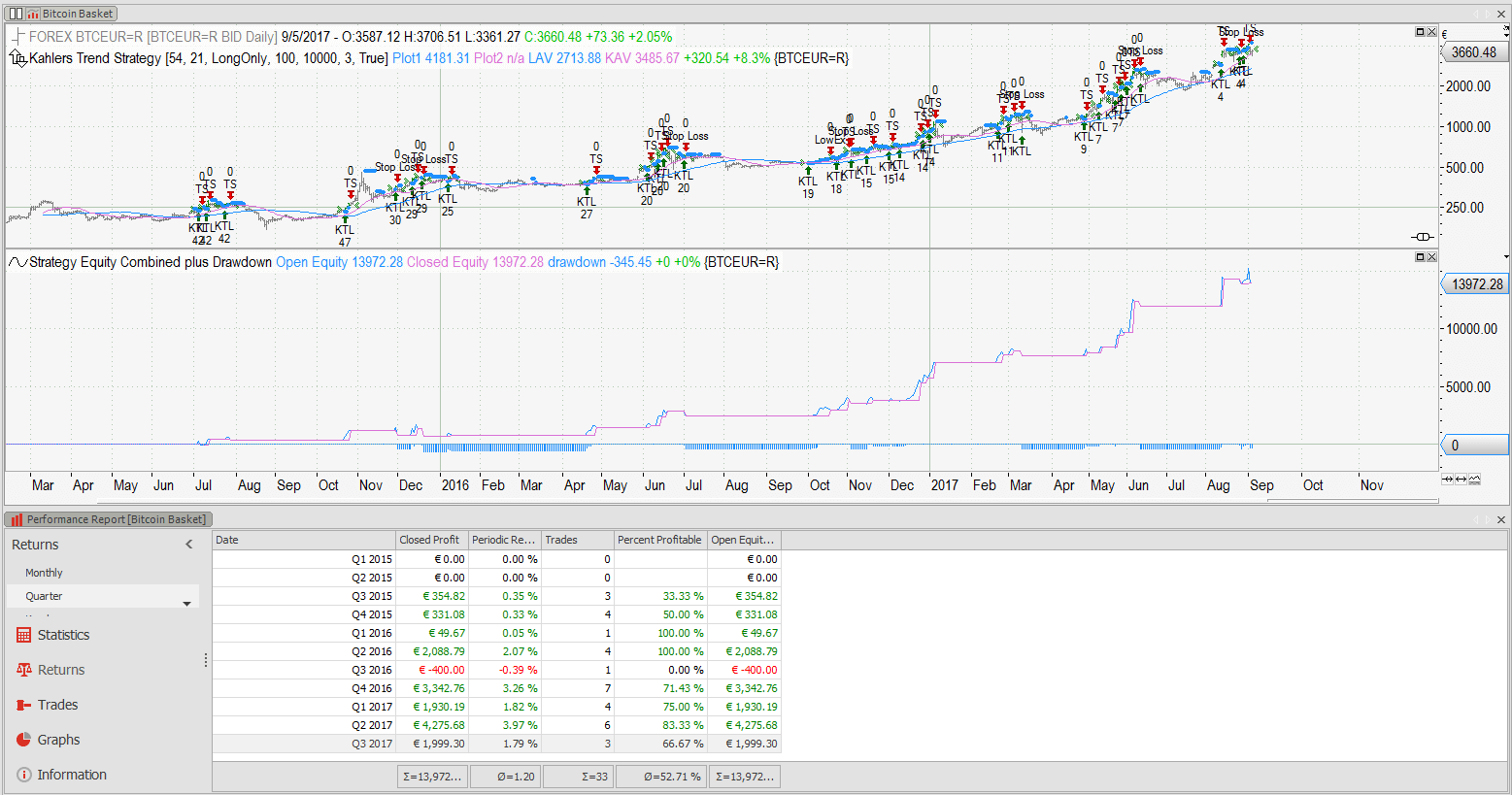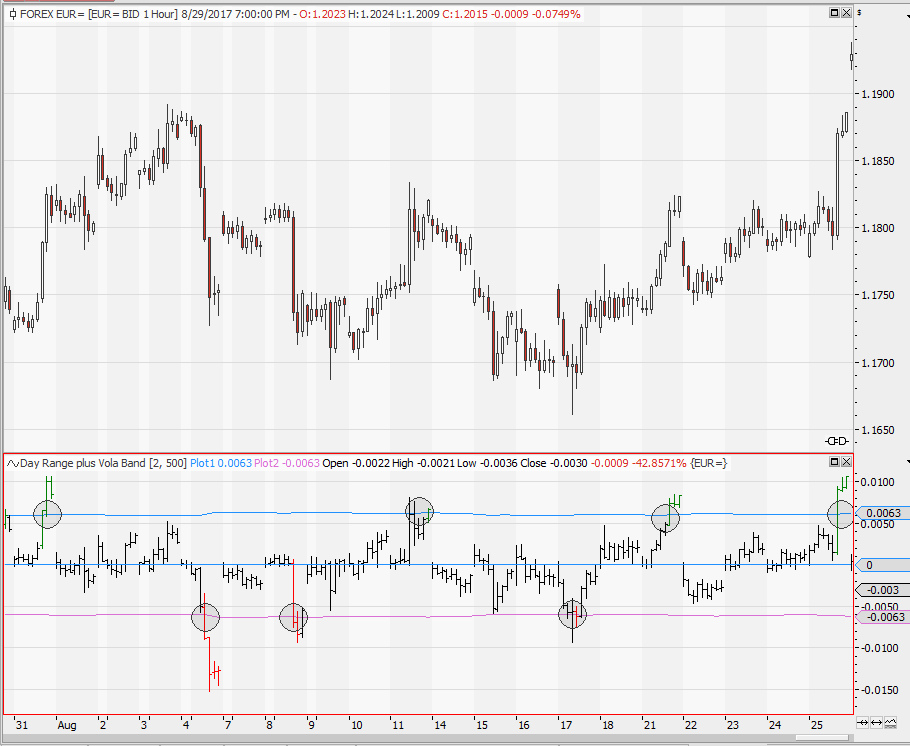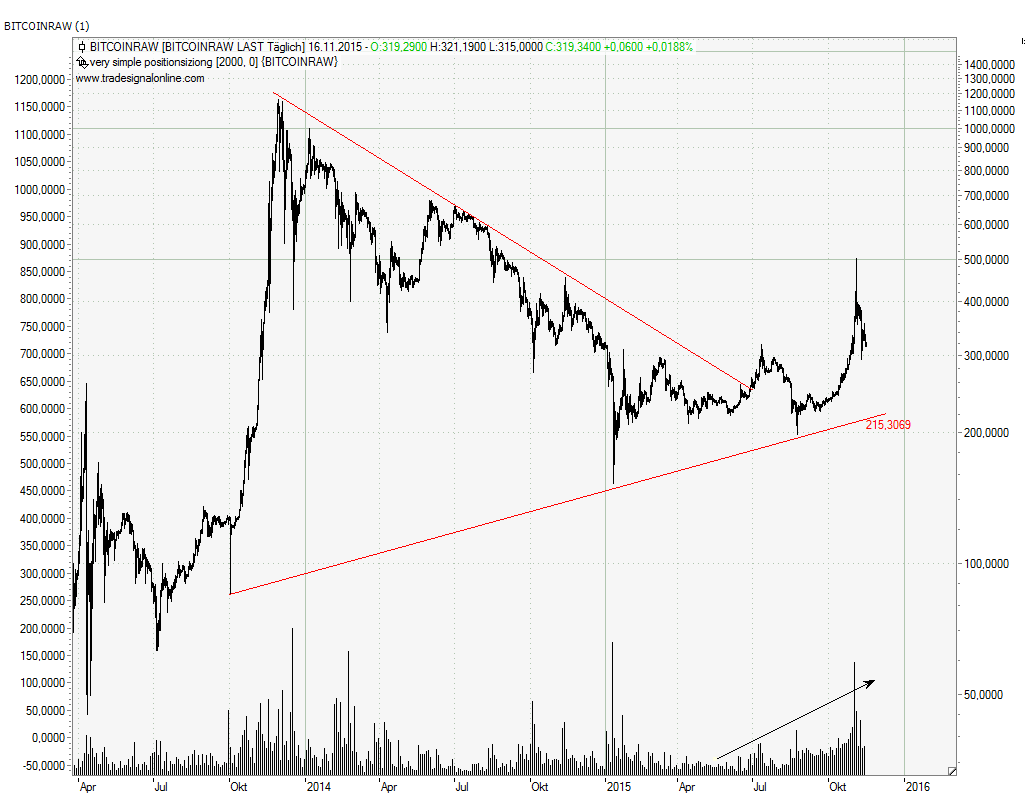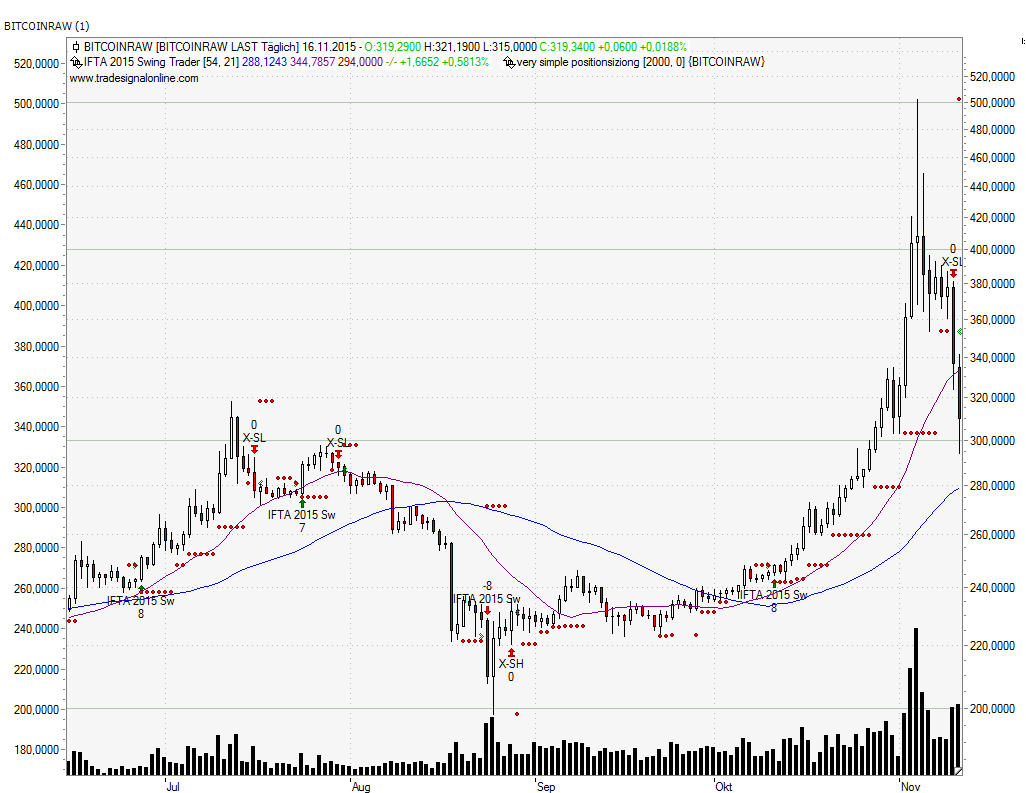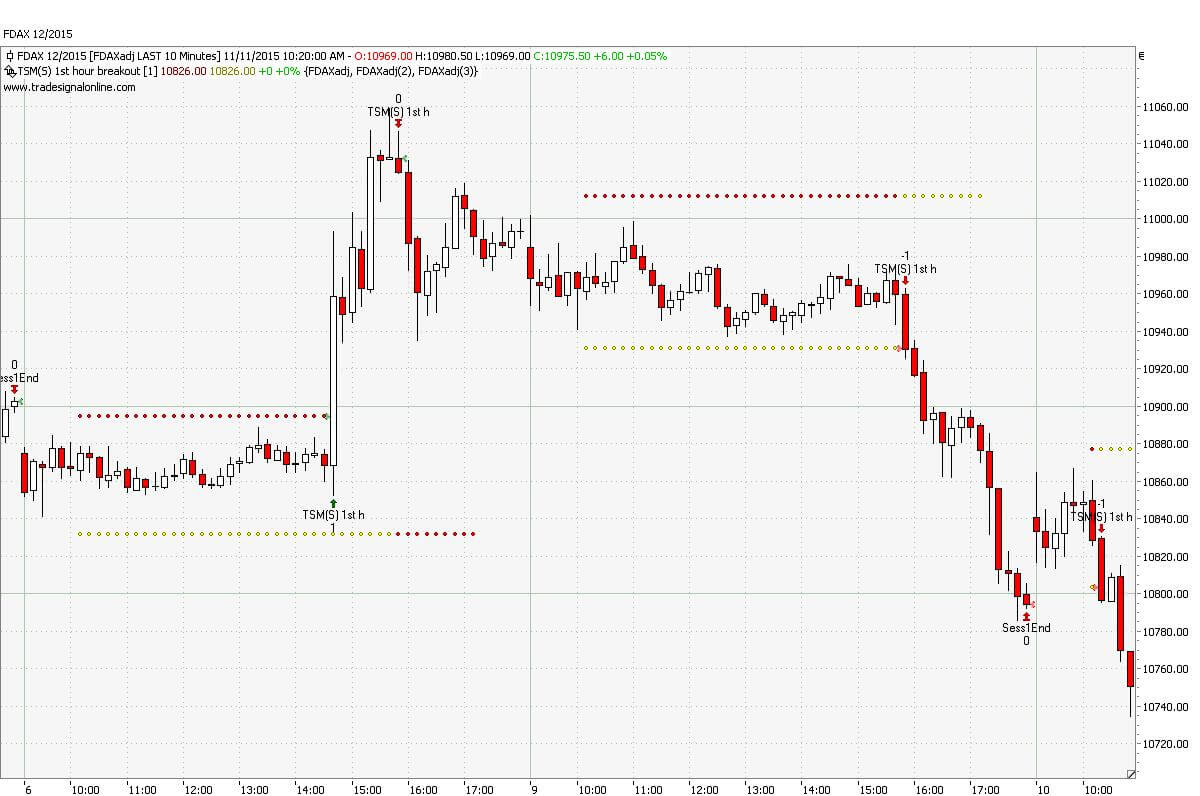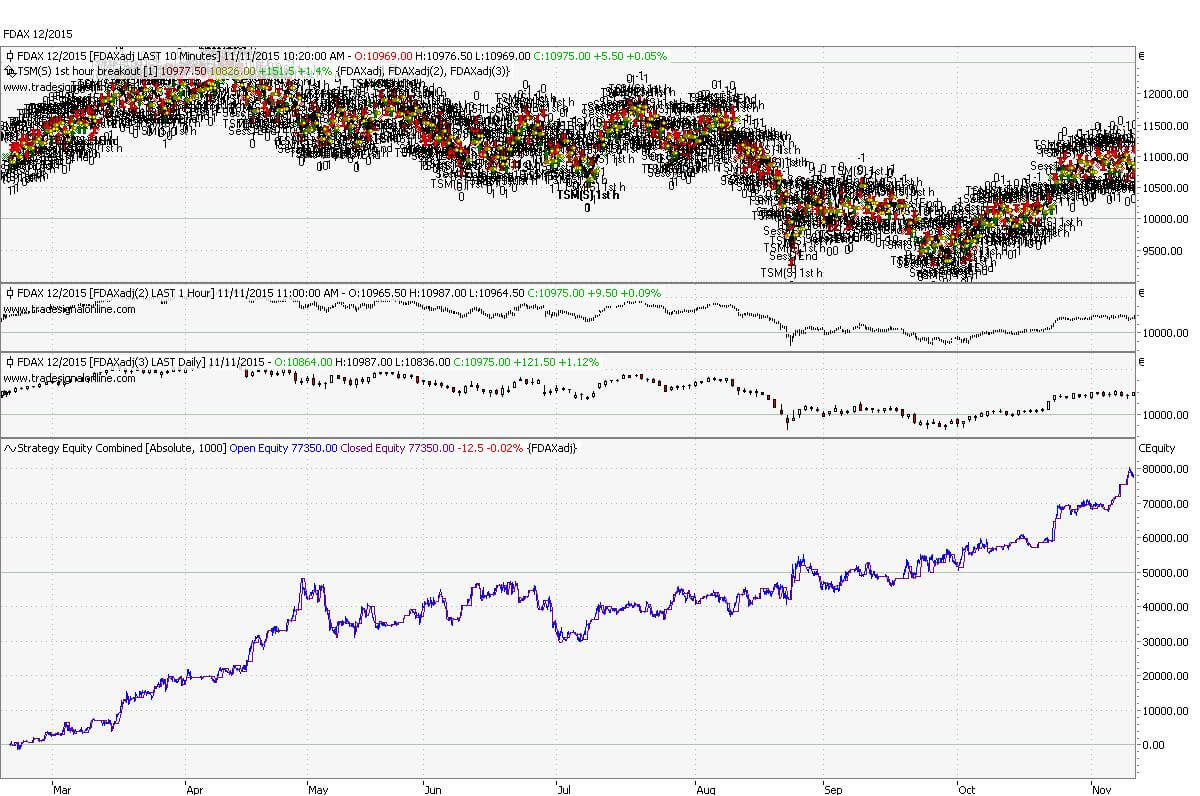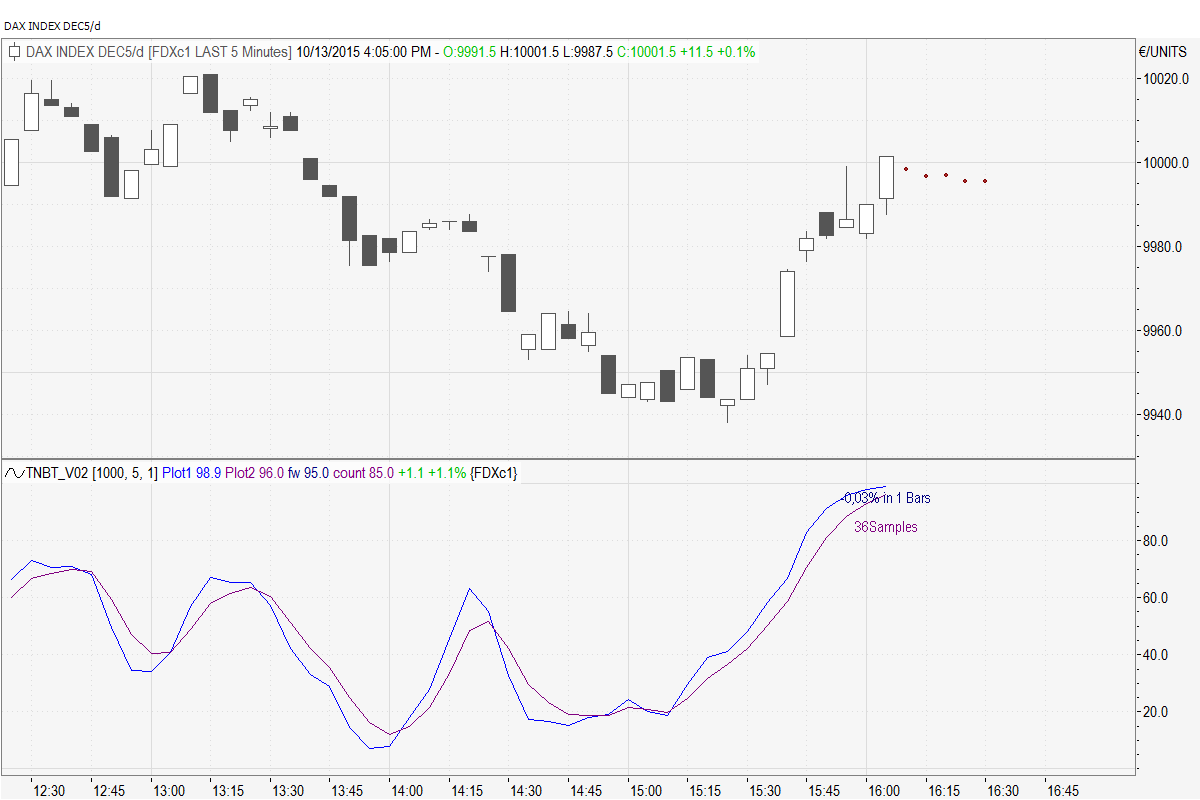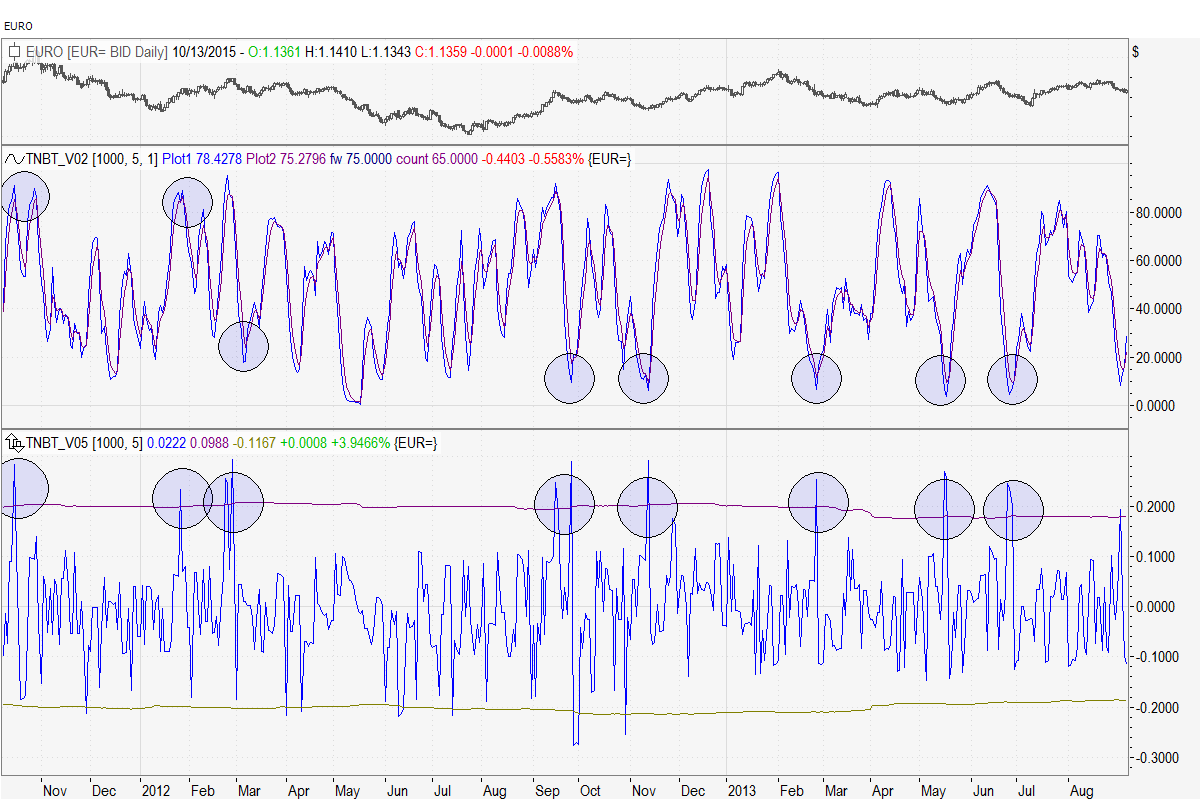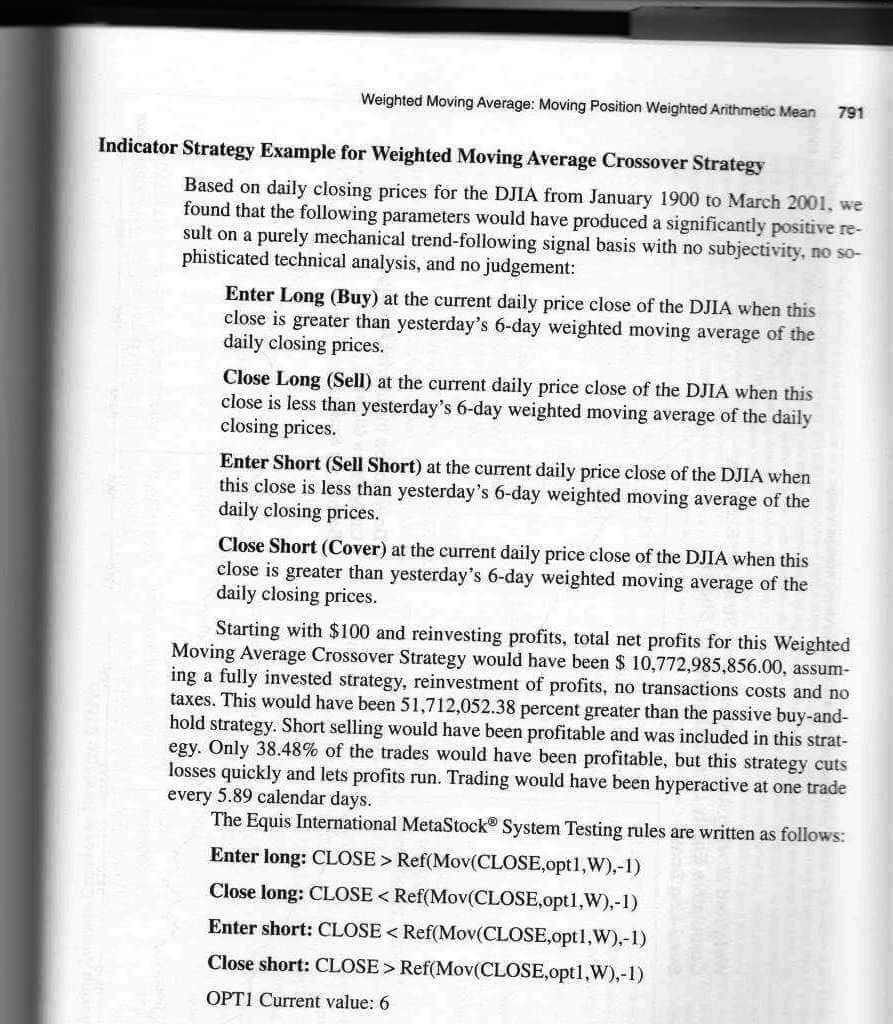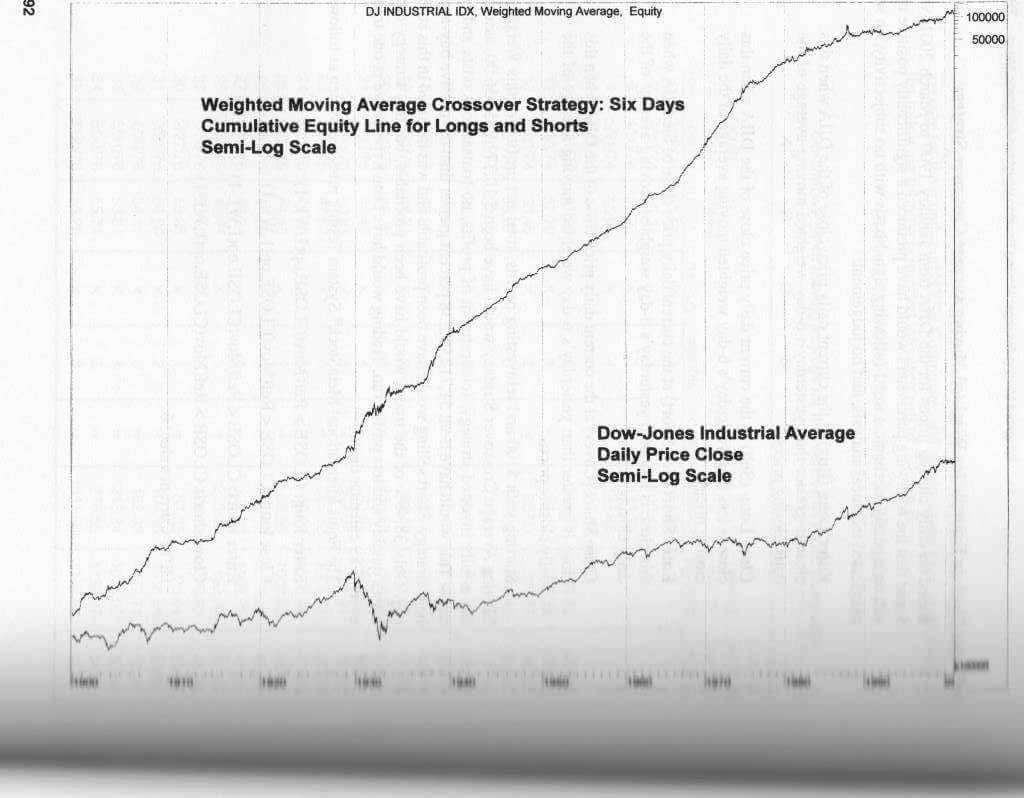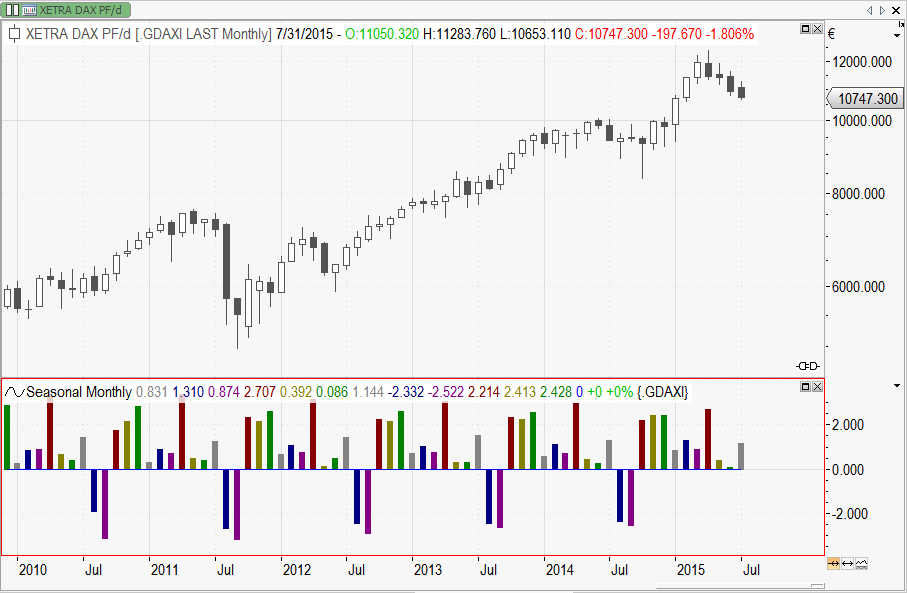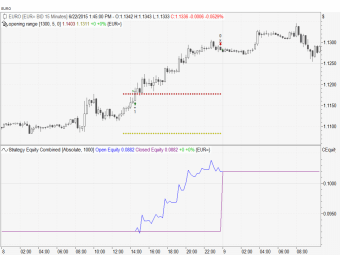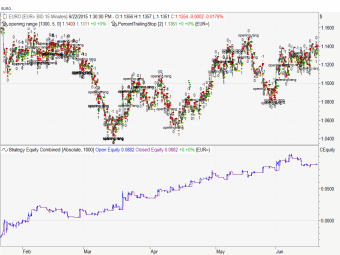The 200 day average is considered as a key indicator in everyday technical analysis. It tells us if markets are bullish or bearish. But can this claim be proved statistically, or is it just an urban legend handed down from one generation of technical analysts to the next? Let’s find out and demystify the 200 day moving average. Continue reading
Trading Strategies
Money for nothing
We already had a post regarding the mean reverting tendency of Volatility, now it`s time to make some money using this information. Continue reading
Statistics of VIX
The CBOE volatility index VIX measures the market’s expectation of future volatility. This article will show you some key statistics of VIX and help you to decide if it is better to buy or to sell volatility.
Statistics of VIX
The spikes to the top and the long phases of relatively low volatility are reflected in a left-leaning distribution diagram and a long tail towards the higher levels. The median value is 17%, meaning 50% of the prices are above (below) this level.
The next chart shows the distribution of returns over 25 trading days. The median price movement being slightly shifted to the negative area shows the mean reverting characteristics of volatility.
Buy or sell volatility?
Analysing the level of VIX and the returns afterwards yields an even more interesting picture:
The green line gives the 25 bar percentage returns of VIX, with VIX noting above 25, the red line gives the returns with VIX below 15. Observe the median of the two lines:
The median 25 bar return with VIX above 25 (green) is around -15%, only 20% of the returns are positive when VIX is currently above 25. Sell volatility.
The median returns with VIX currently below 15 (red) is above 0% and with a fat tail to positive returns. Buy volatility. (data from 2004-2018)
Adverse movement of VIX
The above chart suggests that going short on volatility, if VIX is above 25, seems to be a good idea. But it is not without risk. The chart below shows what can go wrong during the next 25 days. The distribution diagram gives the maximum adverse movement of the VIX, with VIX currently trading above 25.
The green line, VIX currently above 25, shows a +10% median maximum up movement over the next 25 days. So do not expect a short vola position to be without risk. Some adverse movement has to be expected.
On the other side, the distribution of the maximum loss of the VIX during a 25 day period shows a median of below -20%. This represents the profit potential of a short volatility position.
Conclusion of VIX statistics:
If you plan to short volatility wait until VIX is trading above 25. If you want to buy volatility, do so if VIX is trading below 15.
The analysis has been done using the tradesignal software suite.
Machine learning: kNN algorithm explained
I always thought that inspiration and experience are key factors in trading. But every time my chess computer beats me without any inspiration, just by brute force, I get my doubts. This article will be about a brute force approach in trading. The kNN algorithm.
Rule based trading
Rule based trading – algorithmic trading, is just a name for a set of if..then rules which will define the machines trading decisions. e.g. if the market crosses below the 200 day line, then short 100 contracts. If the market rises by 2% then exit the position. Easy stuff like this… (for the beginning)
This article will be a short introduction to machine learning. I will use a classic algorithm of machine learning to let my computer find a prediction for tomorrows market move. In the meantime I’ll have a glass of wine with some friends and let the machine do the job; At least that’s the idea, but can it be that simple in real life trading?
Unsupervised machine learning – kNN algorithm
The kNN algorithm is one of the most simple machine learning algorithms. Learning, in this case, is only a nice sounding label, in reality kNN is more of a classification algorithm.
This is how it woks:

The scatter chart above is a visualisation of a two dimensional kNN data set. For this article I used a classical indicators of technical analysis to do the prediction: a long-term and a short-term RSI indicator. The dots on the two dimensional scatter chart represent the historic RSI values at a given point of time.
Now have a look at the fat circled point. This point represents today’s value. It means, that today’s RSI1 has a value of 63, and RSI2 got a value of 70.
Additionally to the position on the chart the dots have got colours. A green dot means that the market moved up on the following day, a red dot shows a falling market on the day after.
We already know what has happened in history, so it is easy to colour the historic dots. But we do not know the colour of today’s dot, as it is not known where tomorrow’s market will end.
Based on the chart above, will it be a red or green dot? Will tomorrow be up or down? Should I go long or should I go short?
kNN – k nearest neighbours
To do a prediction of tomorrow’s market move, the kNN algorithm uses the historic data shown on the scatter plot above and finds the k-nearest neighbours of today’s RSI values. As you can see, our current fat point is surrounded by red dots. This means, that every time the two RSI values have been in this area, the market fell on the day after. That’s why today’s data point is classified as red. Wish it would be that easy all the times…
Call it classification or prediction, the two dimensional kNN algorithm just has a look on what has happened in the past when the two indicators had a similar level. It then looks at the k nearest neighbours, sees their state and thus classifies today point.
kNN as Tradesignal Equilla Code
In this article I would like to show you an implementation with the Tradesignal programming language Equilla.
To implement the algorithm in Tradesignal we first have to do the shown scatter plot. The algorithm stores the values in an array.
8/9 calculates the value of the fast and slow RSI indicators
12/13 looks what will happen on the day after (for the training data set)
16/17/18 stores everything in an array.

The next task to complete is to calculate the distances of today’s RSI point to all the historic points in the training data set.

23/27 calculates the euclidean distance of today’s point to all historic points, line 29 then creates a sorted list of all these distances to find the k nearest historic data points in the training data set.
Nearly done. The next step is just to find out what classification (colour) the nearest points have got and use this information to create a prediction for tomorrow. This is done in lines 33 to 35

Have a look at the scatter chart at the beginning. If this would be the data stored in our training data set, the prediction, using the 5 nearest neighbours, would be -5. All the 5 nearest neighbours of our current data point are red.
Now that we got a prediction for tomorrow, we need to make use of this prediction and trade it. The returns then will show if everything works as predicted.
Over here I just do a simple long/short interpretation of the prediction, but of course you could also use the quality of the prediction (+5 or +1?) in some sort of way. Position sizing…?

kNN algorithm performance
The next chart shows 2000 bars of daily Brent data. It uses a 14 and 28 day RSI to predict the next day’s move in the Brent oil market. The training was on the first half of the data set, and the 5 nearest neighbours did the classification.
Underneath the chart the returns of this test are shown. (strategy equity). On the bottom of the char you see the two RSI indicators used for the generation of the prediction / buy-sell command.

kNN algorithm – conclusion
The kNN algorithm offers a framework to test all kind of indicators easily to see if they have got any predictive value. Judging on the shown graph it seems to work. It seems to be possible to use these two RSI indicators to predict tomorrow’s Brent move.
But unfortunately this also could be just completely useless curve fitting. It is you who has to select the indicators and their periods and you will have to define if you like the outcome of a selected parameter set. To many degrees of freedom to be sure. The kNN algorithm is useful, but its application in finance has to be treated carefully. Otherwise bad surprises are guaranteed
Not everything can be done by brute force, inspiration and experience are key factors in finance…
The analysis has been done using the tradesignal software suite.
Using Autocorrelation for phase detection
Autocorrelation is the correlation of the market with a delayed copy of itself. Usually calculated for a one day time-shift, it is a valuable indicator of the trendiness of the market.
If today is up and tomorrow is also up this would constitute a positive autocorrelation. If tomorrows market move is always in the opposite of today’s direction, the autocorrelation would be negative.
Autocorrelation and trendiness of markets
If autocorrelation is high it just means that yesterdays market direction is basically today’s market direction. And if the market has got the same direction every day we can call it a trend. The opposite would be true in a sideway market. Without an existing trend today’s direction will most probably not be tomorrows direction, thus we can speak about a sideway market.
Autocorrelation in German Power
But best to have a look at a chart. It shows a backward adjusted daily time series of German Power.

The indicator shows the close to close autocorrelation coefficient, calculated over 250 days. You will notice that it is always fluctuating around the zero line, never reaching +1 or -1, but let`s see if we can design a profitable trading strategy even with this little bit of autocorrelation.
The direction of autocorrelation
Waiting for an autocorrelation of +1 would be useless. There will never be the perfect trend in real world data. My working hypothesis is, that a rising autocorrelation means that the market is getting trendy, thus a rising autocorrelation would be the perfect environment for a trend following strategy. But first we have to define the direction of the autocorrelation:

To define the direction of the autocorrelation I am using my digital stochastic indicator, calculated over half of the period I calculated the autocorrelation. Digital stochastic has the big advantage that it is a quite smooth indicator without a lot of lag, thus making it easy to define its direction. The definition of a trending environment would just be: Trending market if digital stochastic is above it`s yesterdays value.
Putting autocorrelation phase detection to a test
The most simple trend following strategy I can think about is a moving average crossover strategy. It never works in reality, simply as markets are not trending all the time. But combined with the autocorrelation phase detection, it might have an edge.

Wooha! That`s pretty cool for such a simple strategy. It is trading (long/short) if the market is trending, but does nothing if the market is in a sideway phase. Exactly what I like when using a trend following strategy.
To compare it with the original moving average crossover strategy, the one without the autocorrelation phase detection, you will see the advantage of the autocorrelation phase filter immediately: The equity line is way more volatile than the filtered one and you got lots of drawdowns when the market is sideways.

Stability of parameters
German power has been a quite trendy market over the last years, that`s why even the unfiltered version of this simple trend following strategy shows a positive result, but let`s have a test on the period of the moving average.
Therefore I calculated the return on account of both strategies, the unfiltered and the autocorrelation filtered, for moving average lengths from 3 to 75 days.

Return on account (ROA) =100 if your max drawdown is as big as your return.
The left chart shows the autocorrelation filtered ROA, the right side the straight ahead moving average crossover strategy. You don`t have to be a genius to see the advantage of the autocorrelation filter. Whatever length of moving average you select, you will get a positive result. This stability of parameters can not be seen with the unfiltered strategy.
Autocorrelation conclusion:
Trend following strategies are easy to trade, but only make sense when the market is trending. As shown with the tests above, autocorrelation seems to be a nice way to find out if the market is in the right phase to apply a trend following strategy.
Measuring your EDGE in algorithmic trading
There are a lot of statistics which can be used to describe algorithmic trading strategies returns. Risk reward ratio, profit factor, Sharpe ratio, standard deviation of returns… These are great statistics, but they miss an important factor: Are your returns statistically significant or just a collection of lucky noise. The EDGE statistic might me the answer to this question.
Statistics in trading:
If the returns of your trading strategy are positive with in-sample and out-of-sample data this is a first sign that you are on the right path. The next step would be to have a look at the risk-reward ratio of your trading to get an impression if the strategy might be useful in a real world environment.
Assuming that your average yearly returns are about twice as big as the worst case historic draw down you can even be more confident that your strategy is useful. But there is still one thing to check before you can be sure that you are not just seeing a curve fit bullshit strategy. The standard deviation of the daily returns vs. your average daily return.
Defining EDGE in algorithmic trading
Assume your strategy made 250$ over the last year. This averages to about 1$ per day. This 1$ is a good or bad return, depending on the standard deviation of your equity line. If the standard deviation of your equity is 2$, then the 1$ average return strategy would be a bad strategy, as your average returns are way too small in respect to the volatility of your equity. If your volatility of your return curve would just be 50ct and you still make 1$ per day on average, your strategy would be ingenious.
Edge is the ratio of your average returns vs the volatility of your equity line. To be on the safe side, your average return should be about 5% above the 90% confidence interval of your equity line volatility.
The left chart is a strategy trading an one month RBOB time spread, the right chart shows the same strategy trading German power. Rbob has got an edge of 3%, German power has got an edge of 5%.
If I would have to select which market I want to trade with this sample strategy, I surely would select German power over the rbob time spread. Both curves have their up and downs, but rbob is heavily relying on a lucky trade in September. This lead to a high standard deviation of the equity line , giving you a low edge reading.
Conclusion
Observing the ration between your average daily returns vs. the volatility of your equity curve can give you some valuable insights in the quality of your strategy. If it just called a few lucky trades in history, it will also show a high volatility in returns. And this you most probably want to avoid when turning to algorithmic trading. It`s not just the absolute profit at the end of the year, it is also the path you took to get to this number. The smoother, the better!
Tradesignal Equilla Code for the edge indicator:
ask.
Ranking: percent performance and volatility
When ranking a market analysts usually pick the percent performance since a given date as their key figure. If a stock has been at 100 last year and trades at 150 today, percent performance would show you a 50% gain (A). If another stock would only give a 30% gain (B), most people now would draw the conclusion that stock A would have been the better investment. But does this reflect reality?
Percent Performance and Volatility
In reality and as a trader I would never just buy and hold my position, I would always adjust my position size somehow related to the risk in it. I like instruments that rise smoothly, not the roller coaster ones which will only ruin my nerves. So ranking a market solely by percent performance is an useless statistic for me.
Lets continue with our example from above: if stock A, the one who made 50% has had a 10% volatility, and stock B, the 30% gainer, only had a 5% volatility, I surely would like to see stock B on top of my ranking list, and not the high vola but also high gain stock A.
Risking the same amount of money would have given me a bigger win with stock B.
Combining Performance and Volatility
To get stock B up in my ranking list I will have to combine the absolute gain with the market volatility in between. This can be done quite simple. Just add up the daily changes of the stock, normalized by market volatility.Have a look at the formula of this new indicator:
index(today)=index(yesterday)+(price(today)-price(yesterday))/(1.95*stdev(price(yesterday)-price(2 days ago),21))
In plain English: Today’s Vola Return Index equals yesterdays Vola Return Index plus the daily gain normalized by volatility
So if the index has been at 100, the volatility (as a 95% confidence interval over 21 days) is 1 and the stock made 2 points since yesterday, then today’s index would be 100 + 2/1 = 3
Vola Return Index vs. Percent Return Index
Lets have a look at a sample chart to compare the 2 ranking methods. I therefore picked the J.P.Morgan stock.

The upper indicator shows you a percent gain index. It sums up the daily percent gains of the stock movement, basically giving you an impression what you would have won when you would have kept your invested money constant.
The indicator on the bottom is the Vola Return Index. It represents your wins if you would have kept the risk invested into the stock constant. (=e.g. always invest 100$ on the 21 day 95%confidence interval of the daily returns)
Have a closer look at the differences of these two indicators up to October 2016. JPM is slightly up, and that`s why the percent change index is also in the positive area. During the same time the Vola Return Index just fluctuates around the zero line, as the volatility of JPM picked up during this period of time. To keep your risk invested constant over this period of time you would have downsized your position when JPMs volatility picked up, usually during a draw down. No good.

The same can be observed on the upper chart, showing the last months movements of the index. Right now, after the recent correction the percent change index is, like the JPM stock, up again. On the other side the Vola Return Index is still down, due to the rising volatility in JPM.
Vola Return Index – Ranking
Lets put this to a test and rank the 30 Dow Jones industrial stocks according to the percent return index and using my Vola Return Index as a comparison, calculated since 01/01/2015.
The first three stocks are the same, they got the highest vola and highest percent return. But JPM and Visa would get a different sorting. Just see how low the JPM Vola Index is, it would not be the 4th best stock.

Percent returns says JPM and Visa are abou the same, only the Vola Return Index shows that VISA would have been the better investment vehicle compared to JPM. But see for yourself on the chart…

Conclusion
Make sure your indicators show what you actually can do on the market. There is no use in just showing the percent gains of a stock if you trade some kind of VAR adjusted trading style.
Keeping you risk under control is one of the most important things in trading, and using the Vola Return Index instead of just plotting the percent performance can give you some key insights and keep you away from bad investment vehicles. Also have a look at this stock picking portfolio based on similar ideas.
Tradesignal Equilla Code for Vola Return Index:

Position sizing – the easy way to great performance
Working on your position sizing algorithm is an easy way to pimp an existing trading strategy. Today we have a look at an energy trading strategy and how the position sizing can influence the performance of the strategy.
The screenshot shows you the returns of the same trading strategy, trading the same markets, the same time frames and using the same parameters. The returns on the left side look nice, making money every year. The returns on the right side are somehow shaky, and you would have to love volatility of returns if you would think about trading this basket. The only difference between the basket on the right and on the left side is the position sizing.
The energy basket:
The basket trades German power, base and peak (yearly, quarterly, monthly), coal, gas, emissions. All instruments are traded on a daily and weekly time frame chart, using the same parameters. If the daily trading uses a 10-period parameter, the weekly trading would use a 10-week parameter. This limits the degrees of freedom I have when doing the strategy-time frame-parameter merge, thus minimizing the curve fitting trap.
EEX Phelix Base Yearly – Buy Wednesday, short Thursday?
When it comes to simple trading strategies, the day of the week is surely one of the best things to start with. That’s nothing new when it comes to equity markets. Everybody knows about the calendar effects, based on when the big funds get and invest their money. I do not know about any fundamental reason for the day-of-week effect in German power trading, but is seems to be a fruitful approach.
First of all I have to point out that it is not only the day of the week which is important. A strategy that just buys on Wednesdays and sells 1 or 2 days later would be doomed. But if you add a little filter which confirms the original idea, you will end up with a profitable trading strategy.
This filter will just be a confirmation of the expected move: If you suspect that Wednesday ignites a bullish movement, then wait until Thursday and only buy if the market exceeds Wednesdays high. Same for the short side, wait for a new low before you enter!
Have a look at the chart. The strategy shown buys on Thursdays if Wednesdays high is exceeded. The position is closed 2 days after the entry.
If you run a simple test which day of the week is the best to get ready for a long trade the day after then the next chart shows the return on account of the strategy using data from 2012 up to now: (exit one day after entry)
Bitcoin Trading Strategy – review of returns
Bitcoin is not as bullish as it used to be. May it be due to fundamental reasons like transaction cost and slow speed, or maybe the herd found a new playground, whatever it might be, it is a good time to have a look how my bitcoin trading strategy performed.
The bitcoin trading strategy uses two moving averages for the trend detection, and, when the averages say bullish, the strategy will buy if the market moves above it`s old swing high.
The position is protected with an exit at the last swing low and a 3% trailing stop.
But have a look how this simple strategy performed over the last two years:
Trading on a daily timeframe and investing 10000€ with each entry, the strategy managed to get more than a 100% return over the last 2 years.
The rhythm of the market
Usually we chart the market at it’s absolute level. But what, if we would just chart the net daily, weekly, monthly movement? Would this be an advantage? Would this show us new trading opportunities?
The short answer is: Yes! The trend is not everything, and it seems to be of some significance for further movements, if the market has moved more than x % from the beginning of the day, week or month.
But let’s have a look at some charts – and you will see how well it works:
The first chat is an intraday chart of EuroDollar, 8am-5pm CET. It shows you the daily net movement.
STA – Society of Technical Analysts
I am happy to announce that Trevor Neil will be presenting my “VIX Timing for SP500” at the next STA meeting in London.
https://www.sta-uk.org/resources/meetings-events/
I wrote the strategy for the IFTA conference in Tokyo and published it on this site It performed well, and now it is on Trevor to use it for educational purposes and spread the word about the advantages of algorithmic trading.

Bitcoin Handelsstrategie
Die Cryprowährung Bitcoin ist zurück!
Sie erlebte ihren Hype vor 2014, doch ging es seitdem fast nur noch bergab. Nach den Hochs um 1000$ für einen Bitcoin Ende 2013 verfiel der Preis bis auf 150$. Doch diese Zeiten scheinen vorbei zu sein, bitcoin is back!
Bitcoin Chart Analyse
Der Chart zeigt den Bitcoin / USD Verlauf der vergangenen 3 Jahre. Es spring sofort ins Auge, dass die lanfristige fallende Trendlinie im Juni 2015 gebrochen wurde. Seitdem ist neben den Kursen auch das gehandelte Volumen stark am Steigen. (Kurs- und Volumsdaten von bitstamp.net)
Noch immer ist die Volatilität des Marktes extrem hoch, Bitcoin ist ein reines Spekulationsobjekt, beliebt bei Leuten mit Hang zur Weltverschwörung. Dies sind die besten Voraussetzungen dafür, dass eine automatisches Bitcoin Handelssystem funktionieren kann. Die hohe Volatilität ermöglicht zudem mit geringem Kapitaleinsatz ansprechende Gewinne.
Bitcoin Handelsstrategie
ich bin nicht an die Börse gegangen um mir den ganzen Tag Gedanken über Trendlinien zu machen, ein automatischen Handelssystem für Bitcoin ist da schon eher mein Ding.
Meine Bitcoin Handelsstrategie basiert auf klassischem Swing Trading. Die Strategie selbst wurde auf von mir auf der IFTA Konferenz in Tokyo vorgestellt, IFTA Mitglieder können den vollständigen Systemcode auf der Webseite http://www.ntaa.or.jp/ laden.
Die Basis des System sind die Swing Punkte.
Eine programmierte Definition dieser Punkte finden Sie im Swing Point Stop
Kombiniert man diese Swing Punkte mit einer einfachen Trenderkennung, ergibt sich ein hoch profitables Bitcoin Handelssystem.
Bitcoin Handels Regeln:
Opening Range Breakout
Das Opening Range Breakout System wurde im Magazin “Technical Analysis of Stocks&Commodities” im Juli 1994 besprochen, und wie es scheint, funktioniert es, zumindest ohne slippage uns Speasen, noch immer.
Ein Opening Range Breakout System von Perry Kaufmann.
Es wurde im Magazin “Technical Analysis of Stocks&Commodities” im Juli 1994 besprochen, und wie es scheint, funktioniert es noch immer. (ohne slippage) Auch Tony Crabel schrieb zu diesem Opening Breakout System im selben Magazin
Das System wartet die erste Handelsstunde ab und geht dann bei Erreichen eines neuen Hochs oder Tiefs long oder short. Die Einstiegs Order (Stop Buy / Stop Sell) wird nicht exakt auf das Hoch / Tief gelegt, sondern ein paar Punkte darüber /darunter. (hier 20 Ticks)
Tradesignal Programmierung des Opening Range Systems
Durch das laden von drei Zeitreihen, 10min, Stunden- und Tagesdaten gestaltet sich die Programmierung sehr einfach. Dies schränkt jedoch die Flexibilität deutlich ein.
Prinzipiell ist die Strategie der Afternoon Trader Strategie sehr ähnlich, sie weist auch mehr Flexibilität in der Programmierung auf. Auch der Artikel über Range Breaks im intraday Markt basiert auf einer ähnlichen Idee.
Da die hier vorgestellte Systemversion ursprünglich für dieTradestation 2000i in Easy Language geschrieben wurde, ist das Laden von 3 Zeitreihen ein wenig kompliziert gelöst. Aber es funktioniert.
Strategie Backtest mit adjustiertem DAX Future:
zum Opening Range Tradesignal Equilla Code Passwort “code”
Selbstlernende Handelssysteme
Ein jeder kennt die klassischen Indikatoren wie RSI oder Stochastic. Und ein jeder kennt die dazugehörigen Handelsanweisungen: Long, wenn überverkauft, Short wenn überkauft. Und zumindest im Lehrbuch funktioniert das auch. Aber wie sieht das ganze am realen Chart aus? Würden Sie dem Lehrbuch vertrauen und Ihren Kunden auch einen baldigen Kauf empfehlen wenn der RSI unter 20 liegt?
Testen anstatt zu studieren
Schön, wenn ein Indikator im Lehrbuch funktioniert, doch will ich hier ein Verfahren darstellen, bei dem der Indikator selbst angibt ob, wann und wie gut er funktioniert! Dazu habe ich mir für diesen Beitrag den RSI Indikator vorgenommen.
Zunächst wird der Wert des Indikators betrachtet, sowie, ob er steigt oder fällt. Mit diesen beiden Kriterien lässt sich der RSI einfach klassifizieren.
Dann erfolgt der eigentliche Backtest: Innerhalb der letzten 1000 Bars wird nun geschaut, wie sich der Markt bei einem gleichen Indikatorstand (zwischen 90 und 100) und Richtung (über Triggerlinie) verhalten hat.
Am Bild kam dies innerhalb der letzten 100 bars 36 mal vor. Dabei war die durchschnittliche Bewegung innerhalb der darauffolgenden 5 min DAX Futures Kerze -0.03%. Der RSI hat beim aktuellen Stand also eine negative Kurs Prognose.
Dass es auch nach dem nächsten bar statistisch nach unten geht, sieht man an den 5 Prognose Punkten am Chart. Sie zeigen, wie sich der Markt statistisch innerhalb der nächsten 5 Bars verhalten hat, unter der Bedingung, dass der RSI den aktuellen Stand und Richtung hatte.
Markt Performance als Indikator
Der obige Screenshot zeigt den Indikator und die Prognose für den kommenden bar (sowie die 4 darauf folgenden). Er zeigt jedoch nicht, wie sich diese Prognosen in der Vergangenheit verhalten haben, in welchen Bereichen der Indikator in der Vergangenheit seine höchste Aussagekraft hatte. Dies ist am nächsten Chart dargestellt.
Am Bild ist unter dem eigentlichen RSI seine aktuelle prognose für den nächsten Bar dargestellt. Um diese prognose ist ein Bollingerband gelegt, um so die Bereiche zu definieren, an welchen der RSI seine höchste Aussagekraft hat (= die stärkste Bewegung vorhersagt)
Reality vs. Robert W. Colby, CMT
Dont`t believe!
Papier ist geduldig, darum ist es oft besser wenn man selbst testet bevor man ein veröffentlichtes Handelssystem mit seinem Geld ausprobiert. Heute geht es hier um einen Handelssystem out of sample Test
Ein schönes Beispiel dafür ist eine Strategie aus Robert Colbys Buch “The Encyclopedia of Technical Market Indicators“, 2nd edition, 2003, page 791ff.
Darin wird ein einfaches moving average crossover Systeme vorgestellt, welches anscheinend seit beinahe 100 Jahren phänomenale Gewinne verspricht.
Hier eine Kopie aus dem Buch:
Tradesignal Backtest
.VIX .S&P500 Timing Strategie
Der VIX Index als Panikindikator
Der VIX Index stellt die implizite Volatität der S&P500 Aktienoptionen dar. Damit ist er ein sehr gutes Mass für das aktuelle Paniklevel des Marktes. Und Sie kennen sicher die Börsenweisheit “Kaufe, wenn die Kanonen donnern”. Diese beiden Dinge werden die Ausgangsbasis des hier vorgestellten Handelssystems für den S&P500 Index sein.
Sehen Sie sich zunächst den VIX und den S&P500 Index an.
Schnell erkennt man, wie der VIX die Panik des S&P darstellt. In Phasen in denen alle glauben dass alles ist in Ordnung ist, ist das Paniklevel niedrig. 2003-1006, ab 2012 bis heute. In Zeiten in denen alle an das Ende von Allem glauben, ist der VIX hoch. 2001, 2008, 2011…
Der VIX Index als Timing Indikator
Sieht man sich dies mit weniger Kompression an, sieht man, wie sich der VIX zum timing von Kaufentscheidungen im S&P500 nutzen lässt.
Ich habe hierzu das in der traders tool box veröffentlichte multiple timeframe Bollingerband auf den VIX angewandt. Es stellt ein 20-Perioden Bollingeband mit 2 Standardabweichungen auf täglichen und wöchentlichen Daten berechnet dar. An den markierten Tagen liegt nun der Close des VIX über den täglichen und wöchentlichen Bollingerband. Wie man schnell sieht, scheinen dies gute Einstiegspunkte zu sein. Kaufe, wenn die Kanonen donnern und alle die Panik haben…
Nicht in das fallende Messer zu greifen ist jedoch ebenfalls eine nicht zu vernachlässigende Börsenweisheit, und so kauft das System nicht sofort, wenn der VIX über den Bollingerbändern liegt, sondern wartet noch, bis auch der S&P500 über das gestrige Hoch steigt.
Im Anschluss wird die Position mit einem trailing stop von 2-5% oder einem profit target von 5-15% geschlossen.
VIX S&P500 Timing Strategie Backtest
Saisonale Muster: sell in may and go away…?
“Sell in may and go away” Wer kennt nicht diese alte Börsenregel, aber ist sie auch wirklich sinnvoll? Mit dem hier vorgestellten Indikator sind saisonale Muster leicht aufzuspüren und auf ihre Profitabilität zu überprüfen.
Saisonale Muster
Warum saisonale Muster erscheinen, dafür gibt es viele Erklärungen. Weizen ist zur Erntezeit einfach billiger zu haben als in den Monaten davor, der Gasverbrauch ist im Sommer niedriger als im Winter, gegen Ende des Jahres wird noch Geld veranlagt, am Anfang des Jahres abgezogen, all dies hat Auswirkungen auf den durchschnittlichen Preis in diesen Monaten.
Am ersten Chart sehen Sie die meinen seasonal Indikator. Er zeigt die durchschnittliche Monats Performance des DAX (seit 1987) in Prozenten. Jeder Balken stellt einen Monat dar. Die beiden negativen Balken sind der August und September, der hohe rote Balken ist der April.
Sell in may and go away scheint im Dax also nicht so falsch zu sein, nach der guten Performance im April, ist der Mai durchschnittlich deutlich schlechter.
Backtest Seasonal Strategie
Neue Exits und Stops für Handelssysteme
Handelssystem Exit:
Nichts ist für ein Handelssystem so wichtig wie der Exit. Erst wenn der Trade geschlossen ist, ist der Gewinn (oder Verlust) garantiert.
Wenn i9ch ein neues Handelssystem entwickle, dann teste ich gerne verschiedene Standard Exits per drag&drop. In der Handelssystem Entwicklung Toolbox finden Sie die Tradesignal Codes einer ganzen Reihe von solchen Exits.
3 neue Handelssystem Tradesignal Exit Codes
Ich habe zwei 3 neue Exits zur Scriptsammlung der Handelssystem ToolBox hinzugefügt:
Der Timed Entryprice Stop beendet den trade wenn die Position nicht nach einer einstellbaren Zeit im Plus ist. Dies reduziert das allgemenine Marktrisiko
Der Swing Point Exit setzt den Stop auf lokale Hochs/Tiefs. So wird Charttechnik in der Handelssystementwicklung verwendet.
Der Panik Exit ist ein Pattern-based Stop das wird aktiv wenn Euphorie in Panik umschlägt. Ein 2-bar Candlestick Muster gibt hier den richtigen Wert für den Stop an.
Afternoon Breakout Handelssystem
Wie schön wäre ein profitables Handelssystem für das man nur am Nachmittags ins Büro müsste…
Opening Range Breakout System am Nachmittag
Und solch ein System gibt es, es ist ein Klassiker der Spekulation mit System: Opening Range Breakout.
Das Handelssystem macht nichts anderes, als dass es bis zu einem bestimmten Zeitpunkt wartet, und wenn es danach ein neues Hoch oder Tief gibt, geht das System Long oder Short. Während der Wartezeit wird die Range definiert, bei einem Breakout aus der Range wird gehandelt.
Euro afternoon range breakout
Hier ein Beispiel für den Euro:
Das System wartet bis 13:00 und geht dann intraday long da das Vormittagshoch überschritten wurde. Am Ende des Tages wird die Position geschlossen. Overnight ist das System nicht positioniert.
Handelssystem Backtest Euro Dollar
Das sieht nicht nur bei diesem Einzeltrade, sondern auch im Backtest interessant aus:
Solch ein Standardtrick der Handelssystementwicklung funktioniert natürlich nicht nur beim Euro und nicht nur um 13:00, sondern in vielen Märkten.
Ein Beispiel für den Gas Henry-hub Future an der NYMEX und den Tradesignal Handelssystem Code zum System finden Sie auf der Opening Range Breakout Seite.



